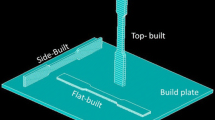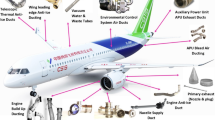Abstract
Hybrid manufacturing (HM), which integrates additive and subtractive manufacturing in one system, has become a popular choice for near-net-shape fabrication of complex parts. Although HM systems have been investigated for decades with major efforts on hardware and motion control system development, less work has been done in the exploration of relationships between microstructure evolution and the HM processing parameters. Here, Ti-6Al-4V thin-wall structures are fabricated according to a design of experiments matrix that includes four main HM processing parameters: layer height, powder feed rate, input energy density, and preheat condition. Optical microscopy is used to characterize the microstructure and relate it to the final part mechanical properties using Vickers hardness test and tensile test. Finite element analysis is applied to predict transient temperature history in the HM process and to help understand the microstructure type formation.






Similar content being viewed by others
References
D.-S. Choi, S.H. Lee, B.S. Shin, K.H. Whang, Y.A. Song, S.H. Park, and H.S. Jee, J. Mater. Process. Technol. 113, 273 (2001).
J. Hur, K. Lee, and J. Kim, Comput. Aided Des. 34, 741 (2002).
S. Akula and K.P. Karunakaran, Robot Comput. Integr. Manuf. 22, 113 (2006).
A. Vasinonta, J. L. Beuth, and M. Griffith, Process maps for laser deposition of thin-walled structures. (utexas.edu, 1999), http://sffsymposium.engr.utexas.edu/Manuscripts/1999/1999-045-Vasinonta.pdf. Accessed 25 March 2018.
K. Salonitis, L. D’Alvise, B. Schoinochoritis, and D. Chantzis, Int. J. Adv. Manuf. Tech. 85, 2401 (2016).
L. Yan, Y. Zhang, F. Liou, and F. Elem, Anal. Des. 144, 30 (2018).
L. Yan, C. Xueyang, L. Wei, N. Joseph, and L. Frank, Rapid Prototyp. J. 22, 810 (2016).
S.M. Kelly and S.L. Kampe, Metall. Mater. Trans. A 35, 1869 (2004).
J.M. Oh, B.G. Lee, S.W. Cho, S.W. Lee, G.S. Choi, and J.W. Lim, Met. Mater. Int. 17, 733 (2011).
S. Malinov, P. Markovsky, W. Sha, and Z. Guo, J. Alloys Compd. 314, 181 (2001).
B.J. Hayes, B.W. Martin, B. Welk, S.J. Kuhr, T.K. Ales, D.A. Brice, I. Ghamarian, A.H. Baker, C.V. Haden, D.G. Harlow, and H.L. Fraser, Acta Mater. 133, 120 (2017).
Acknowledgements
This project was supported by The Boeing Company through the Center for Aerospace Manufacturing Technologies (CAMT), National Science Foundation Grants #CMMI-1547042 and CMMI-1625736, and the Intelligent Systems Center (ISC) at Missouri S&T. Their financial support is greatly appreciated.
Author information
Authors and Affiliations
Corresponding author
Rights and permissions
About this article
Cite this article
Yan, L., Cui, W., Newkirk, J.W. et al. Build Strategy Investigation of Ti-6Al-4V Produced Via a Hybrid Manufacturing Process. JOM 70, 1706–1713 (2018). https://doi.org/10.1007/s11837-018-3009-7
Received:
Accepted:
Published:
Issue Date:
DOI: https://doi.org/10.1007/s11837-018-3009-7




